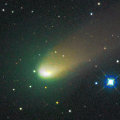
|
Now it is so bright as 9.6 mag (Feb. 10, Carlos Labordena). It keeps observable bright as 9-10 mag in a good condition for a long time until spring. It keeps observable until autumn when it fades down to 16 mag.
Date(TT) R.A. (2000) Decl. Delta r Elong. m1 Best Time(A, h)
Feb. 13 13 35.62 -6 11.1 0.864 1.601 119 9.7 3:59 (183, 61)
Feb. 20 13 46.34 -6 37.4 0.820 1.598 123 9.6 3:48 (180, 62)
|
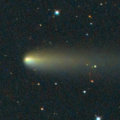
|
It brightened up to 9.5 mag on Jan. 13 (Juan Jose Gonzalez). Now it is still bright as 10.3 mag (Feb. 7, Juan Jose Gonzalez). It keeps as bright as 9-10 mag until spring. It will be observable in good condition for a long time after this in the Northern Hemisphere. It keeps visible visually for one year until autumn.
Date(TT) R.A. (2000) Decl. Delta r Elong. m1 Best Time(A, h)
Feb. 13 14 57.54 44 0.4 2.206 2.679 107 9.6 3:59 (196, 9)
Feb. 20 15 5.74 46 58.3 2.228 2.722 109 9.7 4:08 (190, 7)
|
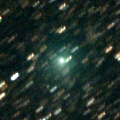
|
Appearing in the morning sky, brighter than expected. Now it is 11.6 mag (Feb. 6, Ken-ichi Kadota). It will reach up to 8 mag and to be observable in good condition in spring.
Date(TT) R.A. (2000) Decl. Delta r Elong. m1 Best Time(A, h)
Feb. 13 18 34.83 -13 40.3 2.317 1.782 46 10.8 3:59 (274, 19)
Feb. 20 18 43.54 -10 15.8 2.163 1.726 51 10.5 4:08 (267, 23)
|
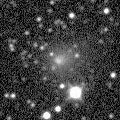
|
Appearing in the morning sky, brighter than expected. Now it is 13.0 mag (Jan. 25, Ken-ichi Kadota). It will brighten rapidly after this, and will be bright as 8 mag in the northern sky in March and April. In the Southern Hemisphere, it will be observable in the low sky after the perihelion passage only.
Date(TT) R.A. (2000) Decl. Delta r Elong. m1 Best Time(A, h)
Feb. 13 20 10.61 12 21.4 1.686 1.044 34 11.4 3:59 (266,-15)
Feb. 20 20 25.52 16 35.3 1.502 0.950 38 10.6 4:08 (259,-13)
|
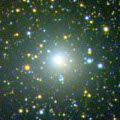
|
It reached up to 7.7 mag in summer (Aug. 13, Chris Wyatt). It is fading now. It has already faded down to 10.2 mag (Dec. 11, Carlos Labordena). Now it is not observable. In the Southern Hemisphere, it will appear in the morning sky in late February, then it keeps observable for a long time. But in the Northern Hemisphere, it is only observable in the low sky in spring, then it will never be observable again.
Date(TT) R.A. (2000) Decl. Delta r Elong. m1 Best Time(A, h)
Feb. 13 20 4.03 -22 2.5 4.642 3.775 25 10.9 3:59 (293, 6)
Feb. 20 20 7.68 -22 41.7 4.614 3.812 31 11.0 4:08 (289, 12)
|
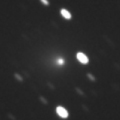
|
It brightened up to 11.5 mag in January (Jan. 12, Juan Jose Gonzalez). It is still bright as 12.3 mag (Feb. 11, Carlos Labordena). In the Northern Hemisphere, it keeps observable in good condition until spring.
Date(TT) R.A. (2000) Decl. Delta r Elong. m1 Best Time(A, h)
Feb. 13 5 49.02 14 50.9 1.297 2.011 122 12.8 20:28 (176, 40)
Feb. 20 5 54.70 15 45.5 1.366 2.021 117 13.0 20:18 (173, 39)
|
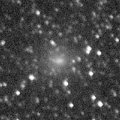
|
It reached up to 8.4 mag in October (Oct. 20, Marco Goiato). Now it is fading. It has already faded down to 12.0 mag (Feb. 2, Juan Jose Gonzalez). It will be too low to observe soon.
Date(TT) R.A. (2000) Decl. Delta r Elong. m1 Best Time(A, h)
Feb. 13 23 40.17 -4 38.4 2.667 1.873 29 13.1 20:28 ( 83, -2)
Feb. 20 23 56.16 -2 47.2 2.747 1.919 26 13.5 20:18 ( 85, -3)
|

|
Great outburst up to 11 mag occured on Feb. 2. Now it is strongly condensed, and very bright as 10.8 mag (Feb. 10, Carlos Labordena).
Date(TT) R.A. (2000) Decl. Delta r Elong. m1 Best Time(A, h)
Feb. 13 9 34.13 12 29.2 5.207 6.193 177 13.5 0:04 (180, 43)
Feb. 20 9 30.85 12 40.2 5.220 6.195 169 13.5 23:29 (180, 42)
|

|
Appearing in the morining sky. It will brighten up to 12-13 mag in summer. But it locates somewhat low in the Northern Hemisphere.
Date(TT) R.A. (2000) Decl. Delta r Elong. m1 Best Time(A, h)
Feb. 13 18 30.65 -24 56.1 3.005 2.443 47 13.8 3:59 (284, 26)
Feb. 20 18 44.72 -25 4.1 2.939 2.441 51 13.8 4:08 (281, 30)
|
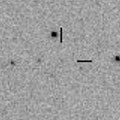
|
Now it is 15.6 mag (Dec. 6, A. Maury, J. B. de Vanssay, F. Mallia, F. Kugel). It will be 14 mag from winter to spring in 2010. But the condition is bad. Now it is not observable. In the Northern Hemisphere, it will appear in the morning sky at 15 mag in late May, then it keeps observable while fading gradually after that.
Date(TT) R.A. (2000) Decl. Delta r Elong. m1 Best Time(A, h)
Feb. 13 22 58.34 -11 1.6 2.628 1.717 17 14.1 20:28 ( 72, -6)
Feb. 20 23 11.61 -7 36.5 2.650 1.714 14 14.1 20:18 ( 74, -9)
|
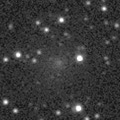
|
Now it is bright as 13.5 mag (Jan. 16, Michael Jager). Very faint large coma is visible in the excellent condition. However, the central nuclear is so faint as 17 mag.
Date(TT) R.A. (2000) Decl. Delta r Elong. m1 Best Time(A, h)
Feb. 13 0 54.92 49 25.3 1.406 1.502 75 14.4 20:28 (138,-18)
Feb. 20 1 0.08 52 4.1 1.423 1.471 72 14.3 20:18 (140,-21)
|
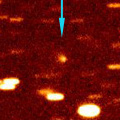
|
It had been brightening as expected until Dec. 29 when it was 16.4 mag (Ken-ichi Kadota). However, it was reported bright as 14.2 mag on Jan. 3 (W. Hasubick). Maybe an outburst. The condition of this apparition is bad. It will reach up to 11-12 mag from spring to autumn in 2010, but it is not observable. It will be too low to observe soon.
Date(TT) R.A. (2000) Decl. Delta r Elong. m1 Best Time(A, h)
Feb. 13 22 59.50 4 58.8 2.839 2.000 26 14.9 20:28 ( 85,-15)
Feb. 20 23 14.36 6 9.5 2.822 1.952 23 14.7 20:18 ( 86,-17)
|

|
It will approach to the sun down to 0.4 A.U. in July, and it is expected to reach up to 4 mag. It keeps unobservable for a while. It will appear in the morning sky at 12 mag in April. In the Northern Hemisphere, it is observable only until June.
Date(TT) R.A. (2000) Decl. Delta r Elong. m1 Best Time(A, h)
Feb. 13 21 42.36 -15 58.7 3.604 2.618 2 15.0 3:59 (303,-16)
Feb. 20 21 49.87 -14 37.3 3.500 2.520 6 14.7 4:08 (297,-12)
|

|
It brightened up to 11 mag in spring and summer in 2009. Appearing in the morninig sky again. It keeps observable after this until autumn when it becomes fainter than 18 mag while fading gradually. But it locates somewhat low in the Northern Hemisphere.
Date(TT) R.A. (2000) Decl. Delta r Elong. m1 Best Time(A, h)
Feb. 13 18 31.54 -25 48.5 3.171 2.600 46 14.9 3:59 (285, 26)
Feb. 20 18 43.70 -25 44.2 3.126 2.624 51 14.9 4:08 (282, 31)
|
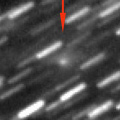
|
It became very bright and observed visually as 9.2 mag (Nov. 18, Juan Jose Gonzalez) and 11.6 mag (Dec. 7, Chris Wyatt) until around the perihelion passage. In January, it approached to the earth down to 0.2 A.U. In the Southern Hemisphere, it is observable in the excellent condition. But it is fading rapidly now. Now it is 14.8 mag (Feb. 5, F. Tifner). It will be fainter than 18 mag in March.
Date(TT) R.A. (2000) Decl. Delta r Elong. m1 Best Time(A, h)
Feb. 13 8 46.08 -4 41.3 0.419 1.382 156 15.0 23:12 (180, 59)
Feb. 20 8 41.85 0 26.1 0.509 1.466 155 15.6 22:40 (180, 54)
|
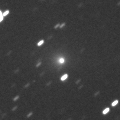
|
Now it is 13.3 mag, already visible visually (Feb. 3, Marco Goiato). It will be observable at 15 mag in good condition in winter and spring.
Date(TT) R.A. (2000) Decl. Delta r Elong. m1 Best Time(A, h)
Feb. 13 4 59.08 19 24.1 1.381 1.970 111 15.0 20:28 (162, 34)
Feb. 20 5 5.90 20 16.3 1.431 1.954 106 15.1 20:18 (160, 32)
|
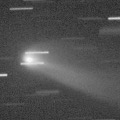
|
An outburst occured on Oct. 13, and it reached up to 8.5 mag on Oct. 15 (Toru Yusa). The central nucleus shined like a bright star, and the dust coma looked like 17P/Holmes in outburst. However, the comet returned to the normal state within a few days. Now it is 13.5 mag (Feb. 2, Juan Jose Gonzalez). It will be too faint to see visually soon. In the Northern Hemisphere, it keeps observable in good condition for a long time until spring when it becomes fainter than 18 mag.
Date(TT) R.A. (2000) Decl. Delta r Elong. m1 Best Time(A, h)
Feb. 13 5 39.01 17 31.8 1.522 2.197 120 15.1 20:28 (173, 37)
Feb. 20 5 44.10 18 28.2 1.651 2.255 115 15.4 20:18 (170, 36)
|

|
Now it is 15.9 mag (Feb. 12, Hidetaka Sato). It was expected to be observable at 15 mag in good condition from winter to spring. But actually, it had been much fainter than expected until January. However, it is brightening very rapidly in February.
Date(TT) R.A. (2000) Decl. Delta r Elong. m1 Best Time(A, h)
Feb. 13 10 31.58 20 42.9 1.289 2.262 166 15.2 1:01 (180, 34)
Feb. 20 10 26.84 21 20.3 1.277 2.255 169 15.1 0:29 (180, 34)
|

|
It brightned up to 10 mag from late 2008 to early 2009. Now it is fading. But it is still bright as 16.4 mag (Feb. 3, Ken-ichi Kadota). It keeps observable in good condition at 16 mag for a while.
Date(TT) R.A. (2000) Decl. Delta r Elong. m1 Best Time(A, h)
Feb. 13 10 2.71 3 17.5 4.669 5.641 168 15.5 0:33 (180, 52)
Feb. 20 9 58.59 3 22.5 4.715 5.695 171 15.6 0:01 (180, 52)
|

|
Now it is 15.5 mag (Feb. 14, E. Bryssinck, S. Farmer, Jr., P. Camilleri, S. Plaksa). It was observed as 15-16 mag in early 2009. In 2010, it will be observable at 16 mag in good condition from winter to spring.
Date(TT) R.A. (2000) Decl. Delta r Elong. m1 Best Time(A, h)
Feb. 13 14 0.08 -4 56.2 3.105 3.623 114 15.6 3:59 (195, 59)
Feb. 20 14 0.85 -4 51.7 3.018 3.628 121 15.6 4:02 (180, 60)
|
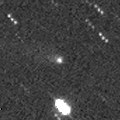
|
Now it is 16.7 mag (Jan. 15, Ken-ichi Kadota), a bit fainter than this ephemeris. It will be observable at 16 mag in good condition until spring.
Date(TT) R.A. (2000) Decl. Delta r Elong. m1 Best Time(A, h)
Feb. 13 15 21.91 24 10.0 2.790 3.128 100 15.7 3:59 (208, 25)
Feb. 20 15 12.87 25 9.2 2.711 3.161 108 15.7 4:08 (197, 28)
|
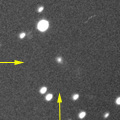
|
Now it is 16.6 mag (Jan. 16, Hidetaka Sato). It keeps observable at 15 mag for a long time in 2010.
Date(TT) R.A. (2000) Decl. Delta r Elong. m1 Best Time(A, h)
Feb. 13 17 31.15 15 33.5 5.133 4.872 69 15.9 3:59 (240, 14)
Feb. 20 17 36.68 16 48.5 5.035 4.851 73 15.9 4:08 (233, 18)
|
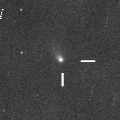
|
It brightened very rapidly, and reached up to 14.8 mag and became visible visually in December (Dec. 4, Juan Jose Gonzalez). But it is fading rapidly now. It has already faded down to 16.5 mag (Feb. 7, L. Buzzi). It will be fainter than 18 mag in late March.
Date(TT) R.A. (2000) Decl. Delta r Elong. m1 Best Time(A, h)
Feb. 13 3 32.93 -6 54.3 1.575 1.790 85 16.1 20:28 (121, 46)
Feb. 20 3 47.90 -6 19.7 1.643 1.807 82 16.3 20:18 (121, 45)
|

|
It brightened up to 13 mag and observed visually from 2007 to 2009. Due to the far distance, it is bright as 14.9 mag still now (Jan. 15, Ken-ichi Kadota). It will be observable in good condition again until spring.
Date(TT) R.A. (2000) Decl. Delta r Elong. m1 Best Time(A, h)
Feb. 13 13 9.70 38 31.6 7.079 7.733 128 16.1 3:39 (180, 17)
Feb. 20 13 4.58 39 21.4 7.062 7.766 132 16.1 3:06 (180, 16)
|
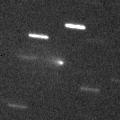
|
Now it is 15.4 mag (Feb. 14, C. Rinner, F. Kugel). It brightened up to 11 mag in outburst in 2003. However, it does not seem to be so bright in this apparition. It seems to be 16 mag at best.
Date(TT) R.A. (2000) Decl. Delta r Elong. m1 Best Time(A, h)
Feb. 13 2 18.62 18 58.6 1.235 1.363 74 16.1 20:28 (127, 15)
Feb. 20 2 42.52 20 5.2 1.260 1.360 73 16.1 20:18 (128, 15)
|
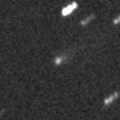
|
Now it is 16.5 mag (Jan. 30, Hidetaka Sato). It will be bright as 14-15 mag in spring. It keeps observable for a long time until September when it becomes fainter than 18 mag.
Date(TT) R.A. (2000) Decl. Delta r Elong. m1 Best Time(A, h)
Feb. 13 14 23.71 -22 36.4 1.355 1.846 102 16.3 3:59 (227, 73)
Feb. 20 14 37.27 -24 2.1 1.273 1.820 106 16.1 4:08 (213, 77)
|

|
Now it is 18.3 mag (Jan. 26, C. Rinner, F. Kugel). It will be getting brighter rapidly in the morning sky. It keeps observable bright as 9-10 mag for a long time from spring to autumn.
Date(TT) R.A. (2000) Decl. Delta r Elong. m1 Best Time(A, h)
Feb. 13 17 23.13 -13 29.4 2.230 1.996 63 16.8 3:59 (263, 34)
Feb. 20 17 39.55 -13 39.5 2.124 1.953 66 16.4 4:08 (260, 38)
|
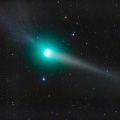
|
It passed near by the earth in late February in 2009, and it reached up to 4.9 mag (Feb. 23, Juan Jose Gonzalez). Now it is 16.8 mag (Jan. 23, Ken-ichi Kadota). It will be low in the evening sky at 17-18 mag in spring.
Date(TT) R.A. (2000) Decl. Delta r Elong. m1 Best Time(A, h)
Feb. 13 4 32.87 20 11.9 4.666 5.022 105 16.6 20:28 (156, 31)
Feb. 20 4 30.31 20 9.1 4.857 5.088 97 16.7 20:18 (151, 29)
|
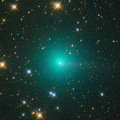
|
It brightened up to 6.7 mag in June (June 9, Marco Goiato). Now it is 15.3 mag (Feb. 16, Hidetaka Sato). A bit brighter than this ephemeris. It will be fading after this, and keeps observable until spring when it becomes fainter than 18 mag.
Date(TT) R.A. (2000) Decl. Delta r Elong. m1 Best Time(A, h)
Feb. 13 12 54.54 47 1.2 2.625 3.329 128 16.7 3:24 (180, 8)
Feb. 20 12 37.88 50 2.7 2.662 3.393 130 16.9 2:40 (180, 5)
|
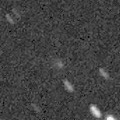
|
Now it is 17.1 mag (Jan. 30, Ken-ichi Kadota). It keeps observable at 17 mag in good condition for a while. It will be fainter than 18 mag in June.
Date(TT) R.A. (2000) Decl. Delta r Elong. m1 Best Time(A, h)
Feb. 13 2 32.59 18 12.5 1.636 1.719 77 16.9 20:28 (128, 17)
Feb. 20 2 46.52 20 13.4 1.670 1.694 74 16.9 20:18 (129, 15)
|
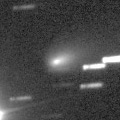
|
It brightened much faster than expected. It became very bright visually at 11.8 mag in December (Dec. 12, Juan Jose Gonzalez). But it is fading rapidly now. It has already faded down to 15.8 mag (Feb. 3, Ken-ichi Kadota). It keeps observable in good condition for a long time. But it will be fainter than 18 mag in late February.
Date(TT) R.A. (2000) Decl. Delta r Elong. m1 Best Time(A, h)
Feb. 13 10 34.06 19 17.6 0.642 1.619 166 16.9 1:04 (180, 36)
Feb. 20 10 29.62 21 8.0 0.680 1.662 169 17.5 0:32 (180, 34)
|
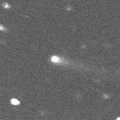
|
Now it is 16.3 mag (Jan. 23, Ken-ichi Kadota). This comet tends to brighten after the perihelion passage. It will be observable at 16 mag in 2010 and 2011. It is brighter than this ephemeris recently.
Date(TT) R.A. (2000) Decl. Delta r Elong. m1 Best Time(A, h)
Feb. 13 4 26.58 23 7.9 2.787 3.182 104 17.0 20:28 (155, 28)
Feb. 20 4 30.84 23 9.8 2.883 3.183 98 17.1 20:18 (152, 26)
|
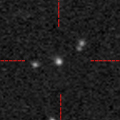
|
Now it is 17.6 mag (Jan. 31, Ken-ichi Kadota). It keeps observable at 17 mag until spring. It will reach up to 14 mag and will be observable in good condition in the next winter.
Date(TT) R.A. (2000) Decl. Delta r Elong. m1 Best Time(A, h)
Feb. 13 6 40.62 69 57.0 3.994 4.525 116 17.4 21:06 (180,-15)
Feb. 20 6 24.55 68 12.5 4.011 4.478 112 17.3 20:23 (180,-13)
|
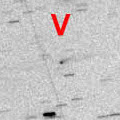
|
Now it is 17.9 mag (Jan. 19, W. Hasubick). It will be fainter than 18 mag in March.
Date(TT) R.A. (2000) Decl. Delta r Elong. m1 Best Time(A, h)
Feb. 13 10 58.04 23 42.2 1.390 2.343 160 17.6 1:28 (180, 31)
Feb. 20 10 51.32 24 58.6 1.423 2.387 163 17.7 0:54 (180, 30)
|
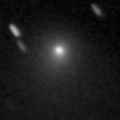
|
Now it is 17.1 mag (Jan. 27, Hidetaka Sato). It will be fainter than 18 mag in April.
Date(TT) R.A. (2000) Decl. Delta r Elong. m1 Best Time(A, h)
Feb. 13 18 34.69 29 37.7 6.535 6.150 63 17.6 3:59 (238, -7)
Feb. 20 18 39.52 30 24.8 6.540 6.201 65 17.7 4:08 (233, -2)
|
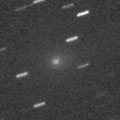
|
Fading slowly. Now it is 17.8 mag (Jan. 24, Ken-ichi Kadota). It will be fainter than 18 mag soon.
Date(TT) R.A. (2000) Decl. Delta r Elong. m1 Best Time(A, h)
Feb. 13 9 35.12 8 47.7 1.916 2.901 174 17.8 0:05 (180, 46)
Feb. 20 9 28.34 9 9.2 1.976 2.953 168 18.0 23:26 (180, 46)
|
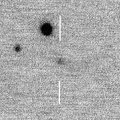
|
Now it is 17.4 mag (Jan. 8, Ken-ichi Kadota). It will be fainter than 18 mag soon.
Date(TT) R.A. (2000) Decl. Delta r Elong. m1 Best Time(A, h)
Feb. 13 9 42.66 36 7.4 2.146 3.080 157 17.9 0:13 (180, 19)
Feb. 20 9 37.35 36 21.6 2.174 3.091 153 17.9 23:35 (180, 19)
|

|
Now it is 18.4 mag (Jan. 13, Ken-ichi Kadota). It will be observable at 17.5 mag in good condition in early 2010 and early 2011.
Date(TT) R.A. (2000) Decl. Delta r Elong. m1 Best Time(A, h)
Feb. 13 5 15.88 21 12.8 3.004 3.545 115 17.9 20:28 (167, 33)
Feb. 20 5 17.19 21 23.3 3.092 3.538 108 17.9 20:18 (163, 32)
|

|
New periodic comet which brightened up to 14 mag in 2004 and 2005. It should be observable at 18 mag also around the aphelion. However, no observations have been reported since 2008 January. It seems to have faded out rapidly. Now it is fainter than 20.4 mag actually (Sept. 16, Leonid Elenin).
Date(TT) R.A. (2000) Decl. Delta r Elong. m1 Best Time(A, h)
Feb. 13 6 19.52 31 10.6 4.240 4.930 129 20.1 20:46 (180, 24)
Feb. 20 6 17.63 31 11.1 4.320 4.921 122 20.1 20:18 (180, 24)
|
|
![]()
 116P/Wild 4
116P/Wild 4 169P/NEAT
169P/NEAT 30P/Reinmuth 1
30P/Reinmuth 1 217P/2009 F3 ( LINEAR )
217P/2009 F3 ( LINEAR ) 94P/Russell 4
94P/Russell 4 C/2006 OF2 ( Broughton )
C/2006 OF2 ( Broughton ) 74P/Smirnova-Chernykh
74P/Smirnova-Chernykh C/2008 N1 ( Holmes )
C/2008 N1 ( Holmes ) C/2008 FK75 ( Lemmon-Siding Spring )
C/2008 FK75 ( Lemmon-Siding Spring ) P/2009 T2 ( La Sagra )
P/2009 T2 ( La Sagra ) C/2005 L3 ( McNaught )
C/2005 L3 ( McNaught ) 157P/Tritton
157P/Tritton P/2010 A5 ( LINEAR )
P/2010 A5 ( LINEAR ) 10P/Tempel 2
10P/Tempel 2 C/2007 N3 ( Lulin )
C/2007 N3 ( Lulin ) C/2008 Q3 ( Garradd )
C/2008 Q3 ( Garradd ) P/2010 A3 ( Hill )
P/2010 A3 ( Hill ) P/2009 Q4 ( Boattini )
P/2009 Q4 ( Boattini ) 203P/2008 R4 ( Korlevic )
203P/2008 R4 ( Korlevic ) C/2010 B1 ( Cardinal )
C/2010 B1 ( Cardinal ) 230P/2009 U6 ( LINEAR )
230P/2009 U6 ( LINEAR ) C/2006 Q1 ( McNaught )
C/2006 Q1 ( McNaught ) 64P/Swift-Gehrels
64P/Swift-Gehrels 232P/2009 W1 ( Hill )
232P/2009 W1 ( Hill ) 31P/Schwassmann-Wachmann 2
31P/Schwassmann-Wachmann 2 P/2004 F3 ( NEAT )
P/2004 F3 ( NEAT )![]()


































